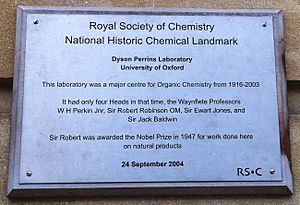Ewart Jones facts for kids
Sir Ewart Ray Herbert Jones (born March 16, 1911 – died May 7, 2002) was a brilliant chemist from Wales. He was known for his amazing discoveries in the world of natural products. These include important chemicals like steroids, terpenes, and vitamins. His work also led to a special chemical reaction called the Jones oxidation.
Early Life
Ewart Jones was born in Wrexham, Wales, in 1911. He grew up in a small village called Rhostyllen. He went to Grove Park School in Wrexham. In 1929, he started studying at the University College of North Wales in Bangor. He hoped to study physics, but he earned a special degree in Chemistry in 1932. The head of the chemistry department, J.L. Simonsen, asked him to stay at the university. He continued his studies there for two more years.
His Family
In 1937, Ewart Jones married Frances Copp. They had met while studying together in Bangor. They had three children: two daughters and one son.
Amazing Discoveries
In 1938, Ewart Jones became a teacher at Imperial College of Science and Technology in London. The Royal Society of Chemistry gave him the Meldola Medal and Prize in 1940. During World War II, he helped train gas officers. After the war, he returned to Imperial College as a Reader and Assistant Professor.
In 1947, when he was 36 years old, he became a chemistry professor at the University of Manchester. There, he experimented with different chemicals. He discovered the Jones oxidation. This is a way to change certain alcohols into other chemicals called ketones. While in Manchester, he also started working with vitamin A. Later, he studied a molecule called hydroxypropanone.
Leading Oxford's Lab
In 1954, he became a top professor at the University of Oxford. He was in charge of the Dyson Perrins Laboratory. He held this important position until 1978.
Awards and Recognition
Ewart Jones was chosen as a Fellow of the Royal Society in 1950. He was given the title of "Sir" in 1963. He led several important chemical groups. He was President of the Chemical Society from 1964 to 1966. He was also President of the Royal Institute of Chemistry from 1970 to 1971. From 1980 to 1982, he was the first President of the Royal Society of Chemistry. In 1966, he won the Davy Medal from the Royal Society. He received this award for his great work in making new organic chemicals. He also helped figure out the structures of natural products.


